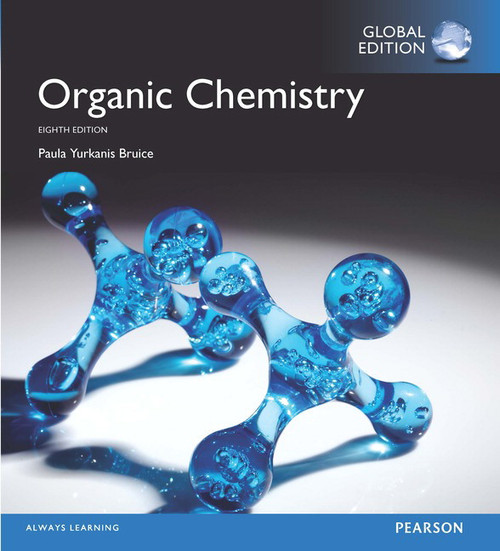Published by Pearson (November 29, 2016) © 2017
Paula BruiceProduct Information
- PART ONE: An Introduction to the Study of Organic Chemistry
- 1. Remembering General Chemistry: Electronic Structure and Bonding
- 2. Acids and Bases: Central to Understanding Organic Chemistry
- TUTORIAL: Acids and Bases
- 3. An Introduction to Organic Compounds: Nomenclature, Physical Properties, and Structure
- PART TWO: Electrophilic Addition Reactions, Stereochemistry, and Electron Delocalization
- TUTORIAL: Using Molecular Models
- 4. Isomers: The Arrangement of Atoms in Space
- TUTORIAL: Interconverting Structural Representations
- 5. Alkenes: Structure, Nomenclature, and an Introduction to Reactivity • Thermodynamics and Kinetics
- TUTORIAL: Drawing Curved Arrows
- 6. The Reactions of Alkenes • The Stereochemistry of Addition Reactions
- 7. The Reactions of Alkynes • An Introduction to Multistep Synthesis
- 8. Delocalized Electrons: Their Effect on Stability, pKa, and the Products of a Reaction • Aromaticity and Electronic Effects: An Introduction the Reactions of Benzene
- TUTORIAL: Drawing Resonance Contributors
- PART THREE: Substitution and Elimination Reactions
- 9. Substitution and Elimination Reactions of Alkyl Halides
- 10. Reactions of Alcohols, Ethers, Epoxides, Amines, and Sulfur-Containing Compounds
- 11. Organometallic Compounds
- 12. Radicals
- TUTORIAL: Drawing Curved Arrows in Radical Systems
- PART FOUR: Identification of Organic Compounds
- 13. Mass Spectrometry; Infrared Spectroscopy; and UV/Vis Spectroscopy
- 14. NMR Spectroscopy
- PART FIVE: Carbonyl Compounds
- 15. Reactions of Carboxylic Acids and Carboxylic Acid Derivatives
- 16. Reactions of Aldehydes and Ketones • More Reactions of Carboxylic Acid Derivatives
- 17. Reactions at the α-Carbon
- TUTORIAL: Synthesis and Retrosynthetic Analysis
- PART SIX: Aromatic Compounds
- 18. Reactions of Benzene And Substituted Benzenes
- 19. More About Amines • Reactions of Heterocyclic Compounds
- PART SEVEN: Bioorganic Compounds
- 20. The Organic Chemistry Of Carbohydrates
- 21. Amino Acids, Peptides, and Proteins
- 22. Catalysis in Organic Reactions and in Enzymatic Reactions
- 23. The Organic Chemistry of the Coenzymes, Compounds Derived from Vitamins
- 24. The Organic Chemistry of the Metabolic Pathways
- 25. The Organic Chemistry of Lipids
- 26. The Chemistry of the Nucleic Acids
- PART EIGHT: Special Topics in Organic Chemistry
- 27. Synthetic Polymers
- 28. Pericyclic Reactions
- Appendix I – pKa Values
- Appendix II – Kinetics
- Appendix III – Summary of Methods Used to Synthesize a Particular Functional Group
- Appendix IV – Summary of Methods Employed to Form Carbon-Carbon Bonds
- Appendix V – Spectroscopy Tables
- Appendix VI – Physical Properties of Organic Compounds
- Appendix VII – Answers to Selected Problems


